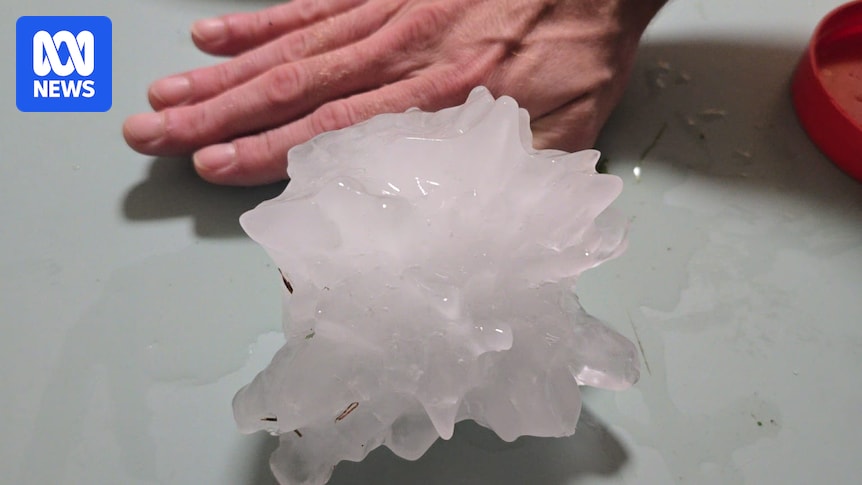For at least the sixth time in as many weeks, parts of south-east Queensland have been lashed by hailstones causing widespread destruction to property and vehicles.
On Monday, giant 14-centimetre hailstones were recorded in Chandler, in Brisbane’s south-east, while 11-centimetre stones fell on the city’s bayside.
The Bureau of Meteorology (BOM) classifies giant hail as stones with a diameter larger than 5 centimetres.
And while residents of the country’s most natural disaster-prone state are no strangers to wild weather, the spate of hailstorms has many questioning if it’s going to become a more regular occurrence.
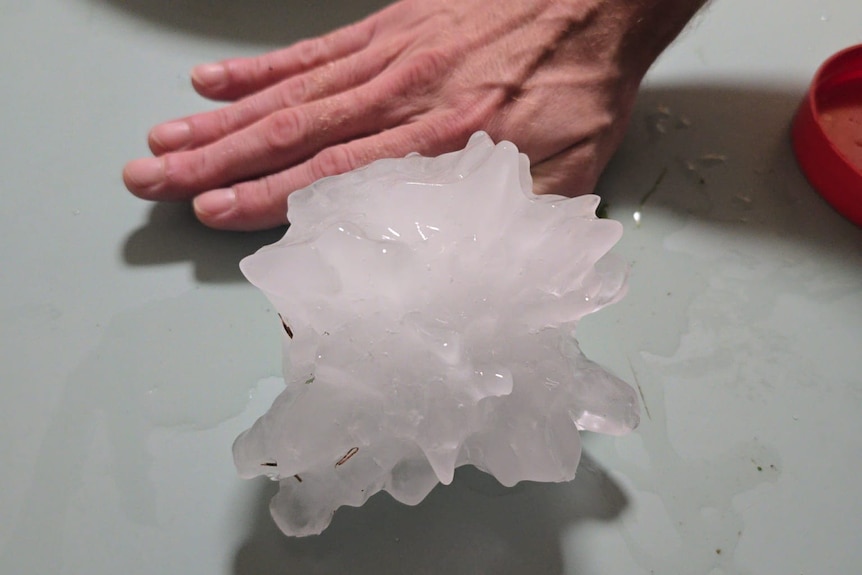
Mitchelton residents say they found hail the size of their hand on Monday afternoon. (Supplied: Kayleen Gordon)
Has there been more hail than usual?
The BOM’s Shane Kennedy said giant hail had appeared on its severe thunderstorm warnings 10 times since July, which was “unusually active”.
Hail threat rises with climate change
He said about four giant hail warnings would be standard, and this time last year the BOM had issued seven for the region.
But climate scientist Tim Raupach says it’s really just too early to make a call on whether there’s been more hail than “usual”.
The senior lecturer at the University of New South Wales Institute for Climate Risk and Response says there’s “an awful lot of variability between years when it comes to hail”.
“This year seems like it’s going to be a year where we have more events,” he explains.
“But whether it’s out of the ordinary is much harder to judge.”

Hail broke a window in the Brisbane suburb of Keperra when Monday’s storms swept through. (Supplied)
What’s causing all the hail?
Nonetheless, Dr Raupach says the right kind of atmospheric conditions for hailstones are certainly around, and have been on a number of occasions this year.
He says “certain ingredients” – like moisture in the atmosphere and heating of the surface – are needed to create hailstones.
“You need a lot of sunlight and you need the atmosphere to be unstable,” he notes.
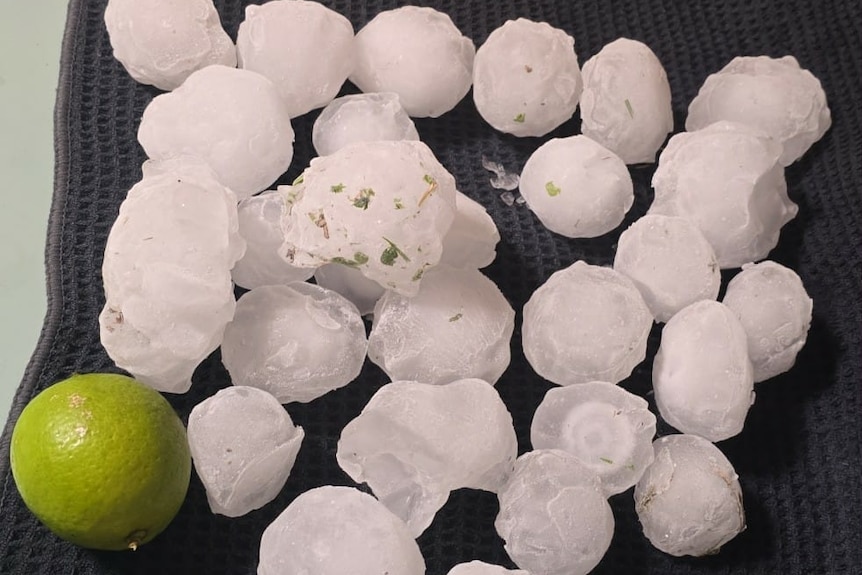
Giant hail was photographed across south-east Queensland earlier this week. (Supplied: Kayleen Gordon)
Should we expect more storms, and larger hail?
BOM research scientist Joshua Soderholm says it is difficult to say with any certainty what the rest of the season has in store because thunderstorms are very “sensitive” and conditions have to be just right for them to develop.

Queensland is in peak storm season, as seen at Caloundra as the storm arrived on Monday evening. (ABC News: Scott McDonald)
He says storms around this time of year generally start becoming more tropical in south-east Queensland, bringing with them more rain and less hail.
But that hasn’t happened yet, because the south-easterly winds needed for that change, have yet to pick up.
“There’s no clear end in sight, but hopefully it’s just around the corner,” he says.

Large hail caused damage to cars in Esk when a storm hit earlier this month. (Supplied: Jon Betts)
In the long-term, the experts warn that it likely we will see more storms and hail.
Dr Raupach says as the climate changes, it is likely the atmosphere will become more unstable, because it contains more water, and therefore, more energy to release.
But while stronger storms could lead to larger hailstones forming, a warmer atmosphere can also mean hail will melt.
“So, that’s kind of an off-setting effect,” he says.
Some of Dr Raupach’s research has predicted the overall frequency of hailstorms to increase in Brisbane in the future, while giant hail is expected to be more frequent in the country’s south-east and south-west.
Any record-breaking hail?
Not yet.
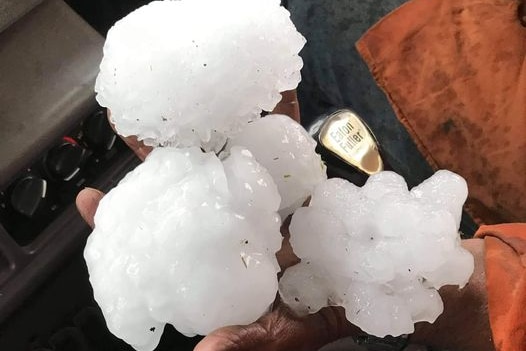
Giant hailstones of up to 16-centimetres fell in Mackay in 2021. (Supplied: John Caporn)
The largest hailstones ever measured in Australia were in Mackay, in 2021, when stones of 16 centimetres were recorded.
Dr Raupach says giant hail like south-east Queensland has experienced this season is rare, but not unheard of.
Hailstones are, of course, extremely destructive at that size, damaging cars and smashing windows.
And he says the damage caused only intensifies as the stones get larger, and the storms get more destructive, with higher wind speeds pushing hailstones sideways.
Giant hail hit Queensland causing injuries and damage — why?
How is hail really measured?
In some ways, with great difficulty, Dr Raupach says, simply because hail starts to melt as soon, or even before it reaches the surface.
Physically measuring them is not that difficult, he explains.
It’s either done with a ruler or calipers, and by taking measurements along the stone’s axes.
Some experts at the BOM will use 3D scans to get an accurate measurement of the volume of the stone.
Hail can also be measured by comparing the size to a reference object – like a cricket ball, golf ball or so.
Dr Soderholm and a group of other researchers at the University of Queensland are also building a hailstone library, and are encouraging people to save them if they can and send them in to be studied.
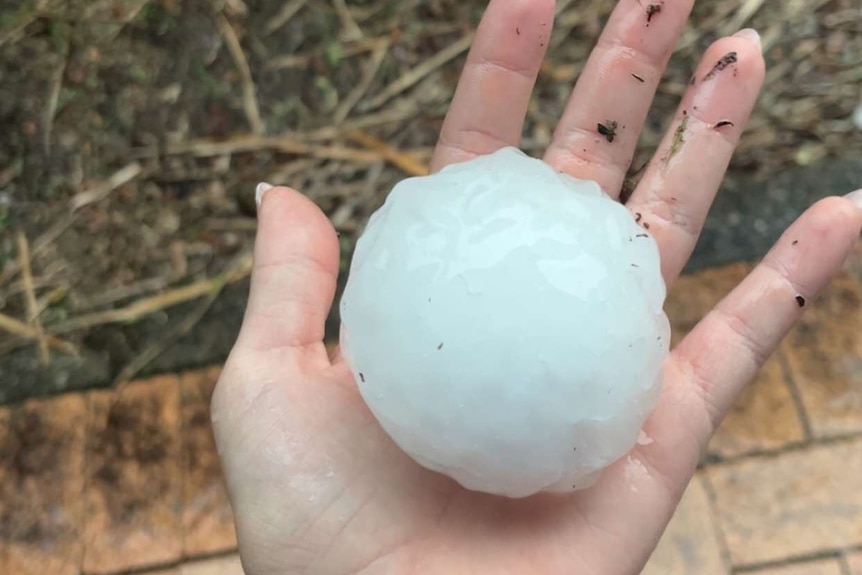
Giant hail fell at Cornubia on Monday afternoon. (Supplied: Madison Fealy)
Why are they such funny shapes? 
Unusually-shaped hail has been falling across south-east Queensland, including at Michelton on Monday evening. (Supplied: Kayleen Gordon)
Many would have noticed that pictures of hailstones which have fallen across south-east Queensland in the past few weeks show they are quite oddly-shaped.
Dr Soderholm explains that’s due to the way those particular hailstones are forming and the size of the “updrafts” in the storm, which is where hailstones grow.
“What we’re seeing lately is thunderstorms that have a huge amount of moisture and also very strong, very broad updrafts,” he says.
Those conditions mean hailstones can not only grow for longer, but also take on unusual shapes.
That’s because water flows over them and does not have time to freeze, instead forming icicles on the hailstone’s “extreme points”.

Experts advise against using hailstones to cool down your drink. (Supplied: Jessica Adams)
So, can I use a hailstone as an ice cube?
As parts of the state swelter through heatwave conditions, it’s unsurprising to see some people using hailstones to cool down a drink.
Both Dr Raubach and Dr Soderholm advise against this.
Not only does a hailstone pick up dirt from the ground once it lands, Dr Soderholm says they can also pick up dirt – and even insects – as they fall.
“There’s been studies which have shown that hailstones will contain microplastics as well, so it’s not quite as pure as you might think,” he says.
Loading…

